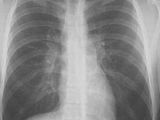Since their discovery, the X rays keep on surprising the scientists with new applications, both related to current life and to the astronomical research.
These are the most powerful radiations, able to penetrate the matter and reveal us its intimacy.
It started in 1895, when Wilhelm Roentgen was studying the recently discovered cathodic rays. In one of the experiments, electrical discharges were launched inside a tube with a mix of gases at low pressure. To his surprise, he observed that each charge made a fluorescent screen glow, even if the tube was partially wrapped in a black cardboard.
It was obvious that some type of radiation came off during the experiment and was able to pierce through the cardboard. When he focused on the phenomenon, he found these rays could affect a photographic plate, and when the hand was interposed, he could see extraordinary details inside the hand, like bones inside the flesh (today we call this radiography).
Roentgen supposed there must have been a type of electromagnetic radiation (fact proved by Felix Von Laue in 1912), like the light or the radio waves discovered by Hertz eight years before, even if of different wavelengths.
As Roentgen could not prove his guess, he named his discovery as "X rays", for their mysterious nature.
In medicine, X rays started to be employed two years after their discovery and even if currently, other systems of visualizing the interior of the body appeared, X rays keep on being the main method employed. Soon after, Von Laue developed one of the most important application fields for X rays: the study of the atomic and molecular structure of the material through refraction.
This property of the X rays was crucial in developing the crystallography, the study of the structure of the crystalline substances, mineral or not, as chemical compounds, like proteins, can be investigated by this mechanism.
This way, the structure of the hemoglobin or insulin was determined and in 1953, Watson, Crick and Wilkins, employing X ray technology, revealed the double helix structure of the DNA.
But the greatest application perspectives for X-rays have just begun.
Many research centers built giant machines, for achieving an intense, modulated and very energetic source of X rays, able to penetrate the matter in a more precise way and to deliver more intimate details of the inside of the atom. These are synchrotrons, particle accelerators similar to those employed by high energy physics.
Knowing in detail the atoms and molecules has applications in physics, chemistry, biology and medicine.
The black holes, invisible by definition, are the most enigmatic space bodies and astronomers can locate them only by using X rays. When a space object is attracted by black hole, it falls in spiral and accelerates to speeds close to light, emitting an intense X radiation before being swallowed. This is the main trait of the black holes.
The first researcher who developed in 1962 the instruments which allowed the detection of the first space X rays sources was Ricardo Giacconi. By now, many space bodies were detected as X ray emitters: binary stars, galaxies, white dwarfs, supernova remains and quasars.

 14 DAY TRIAL //
14 DAY TRIAL // 
